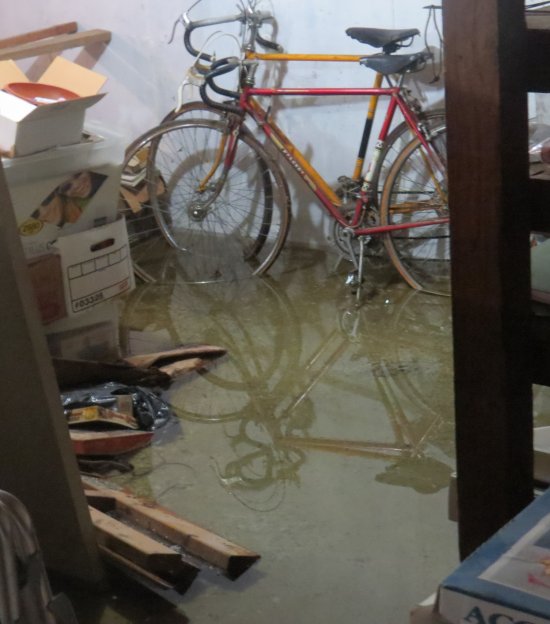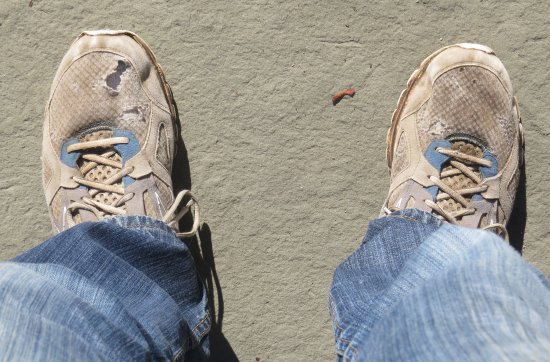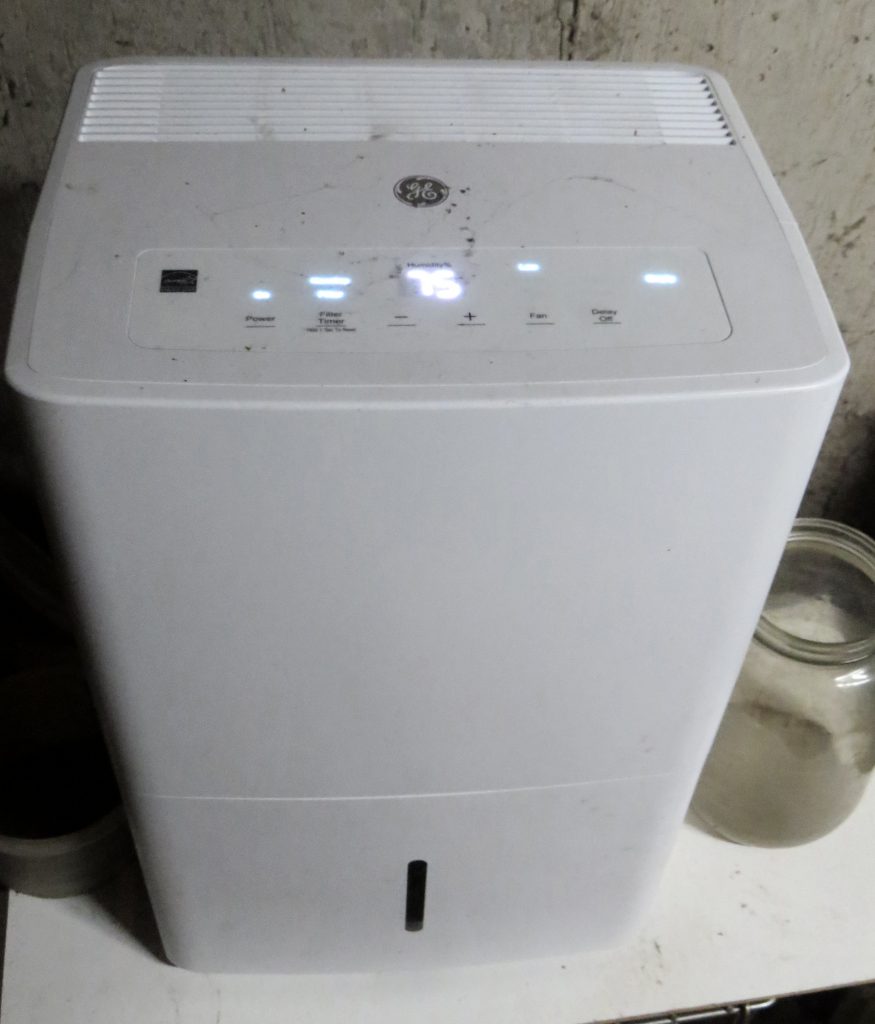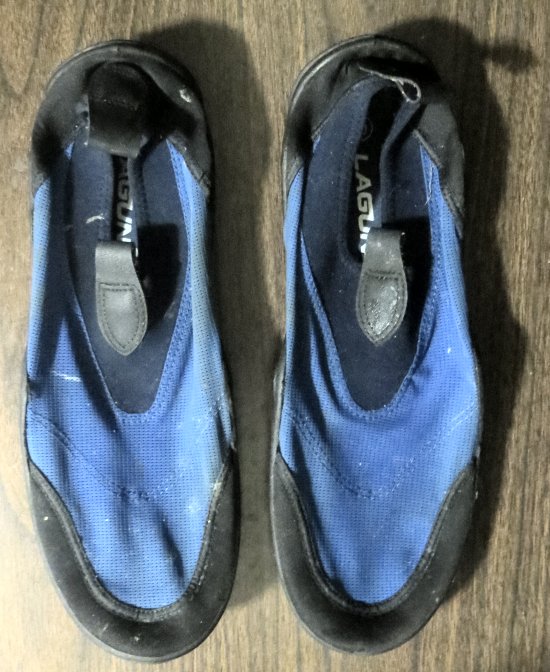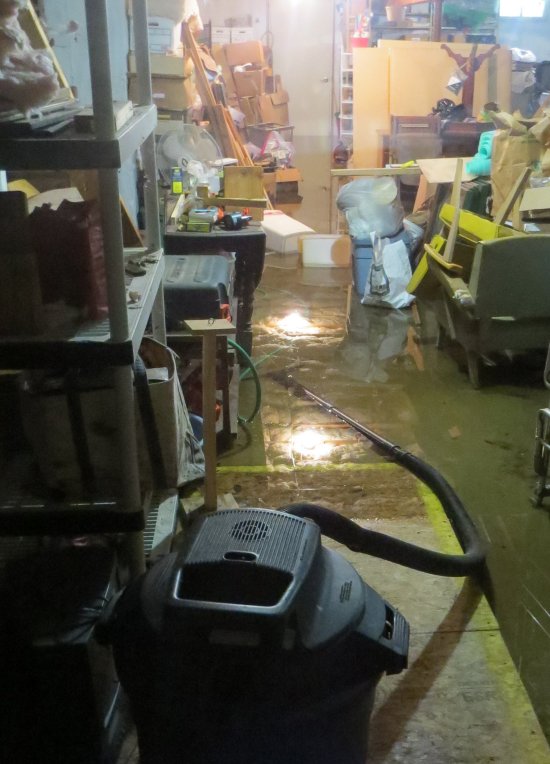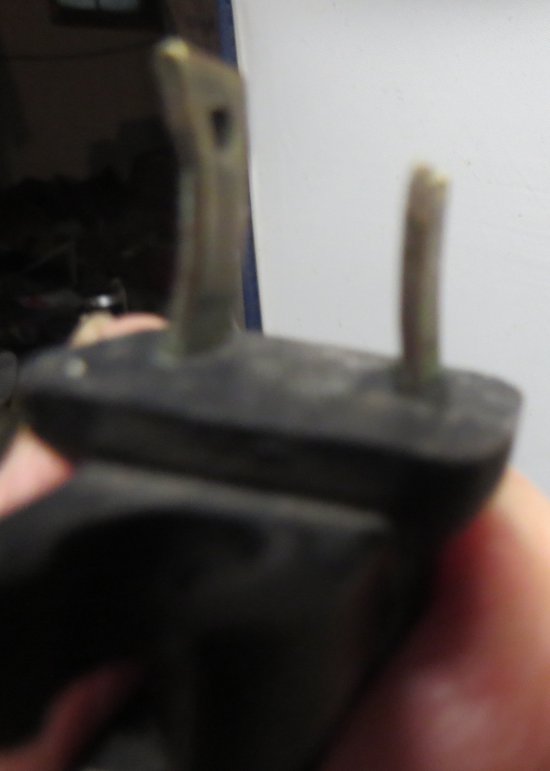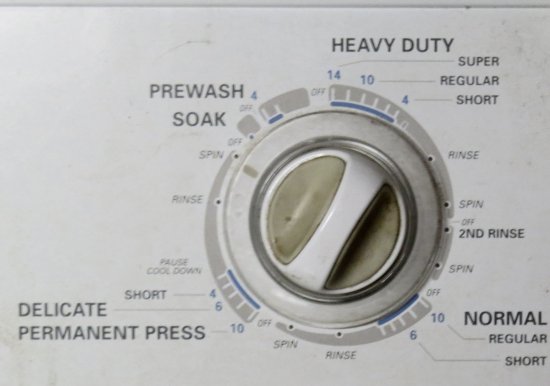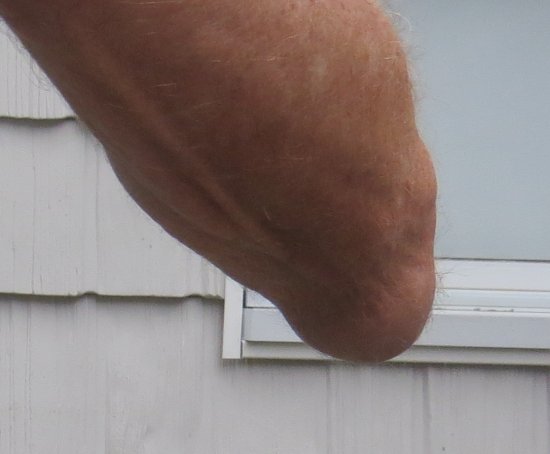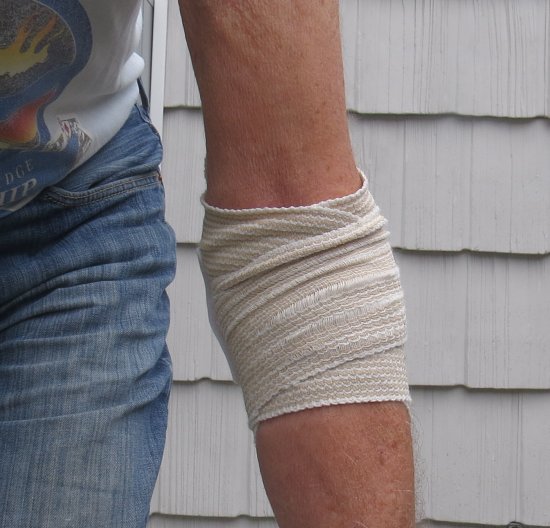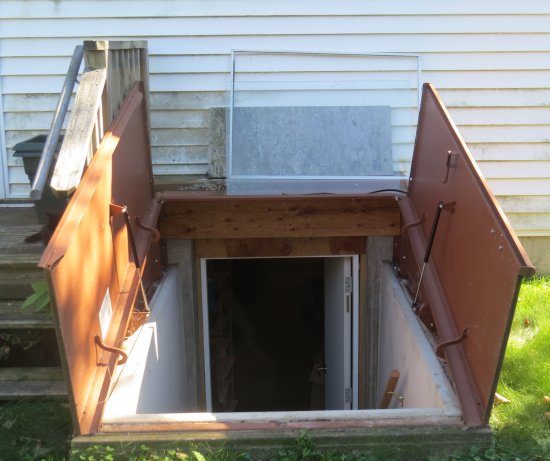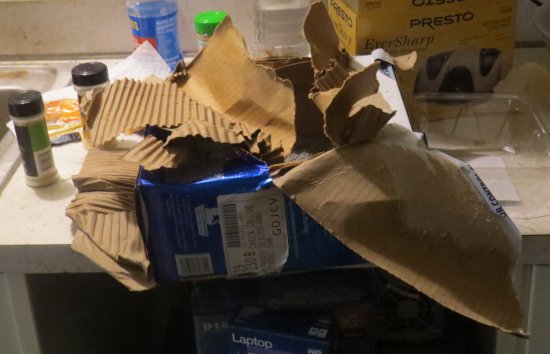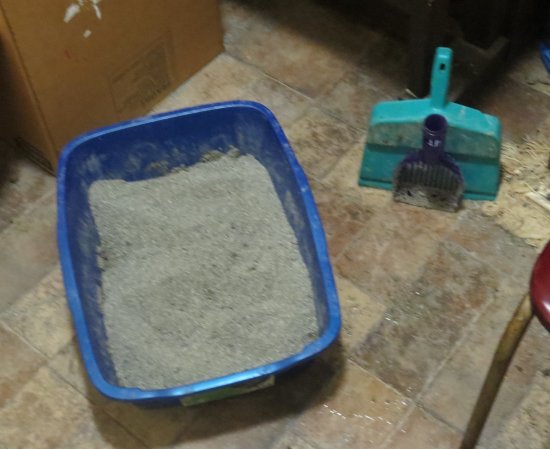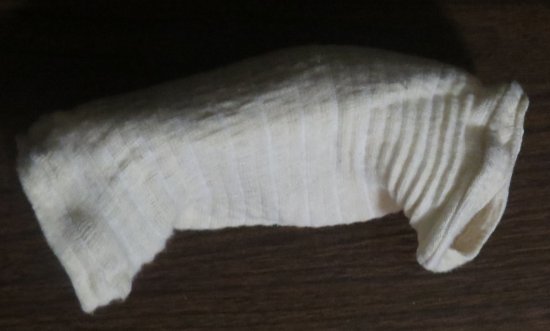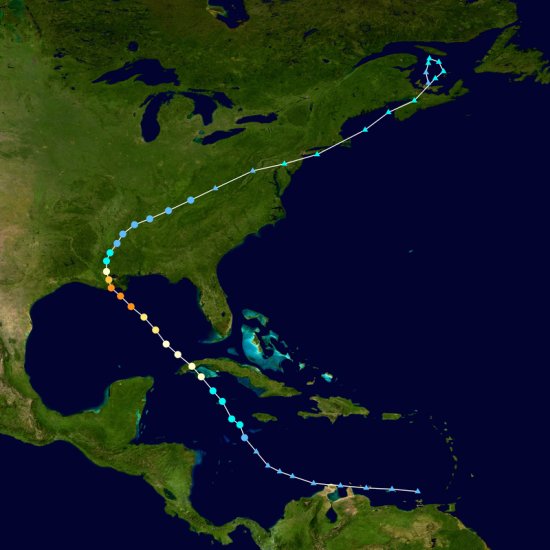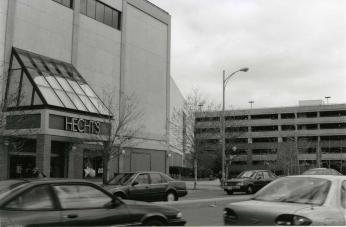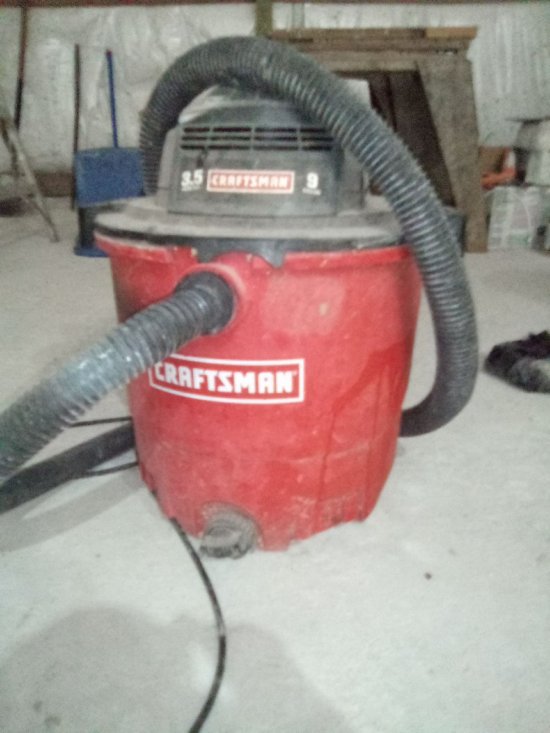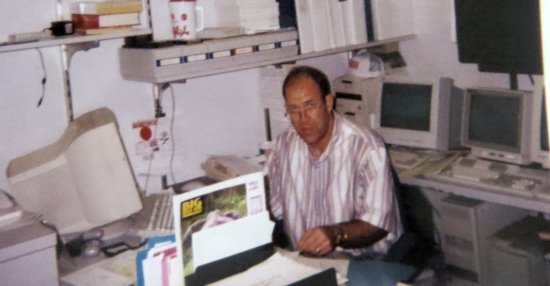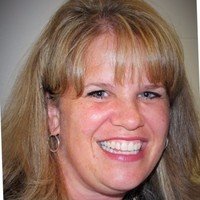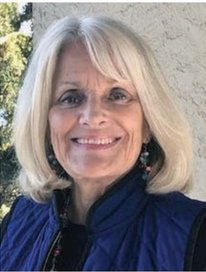Water water everywhere. Continue reading
The remnants of Hurricane Ida1 arrived in southern New England on Wednesday, September 1, 2001. It rained pretty heavily in Connecticut all evening and well into the morning. I was scheduled to play bridge on Thursday at 10AM. I heard on the radio of floods in Manchester and Vernon, about fifteen miles to the south of where we lived in Enfield. I could see no signs of damage in our yard, and there was no standing water in our yard.
This last bit of news was a huge relief. A few weeks earlier a weird localized storm had deluged Enfield and Suffield for a couple of hours. The rest of Connecticut seemed unaffected. For the first time in the thirty-three and a half years that Sue and I had resided at 41 North St. water had somehow seeped into the old part2 of the basement. It was not exactly flooded, but there was a little water in some areas, notably the southeast corner, which was piled high with boxes and who knows what. The new part of the basement was completely dry. It took a few days, but the dehumidifier dried up the old side pretty well.
I also walked out into the yard. I saw several inches of water in the yard that faced North St. The water disappeared when the drain in the street was cleared, but the sod remained squishy.
The feeling of relief was short-lived. Before I left for the Hartford Bridge Club on Thursday morning I checked the basement. Both the old part and the new part were dry. After I finished playing, drove back home, ate lunch, took a nap, and went for a walk, I descended the staircase to the basement to empty the dehumidifier. I was aghast to see that there was considerable water in both halves of the basement.
I could see that the cats’ litter box was sitting in a little water in the new part of the basement. My very old cat Giacomo was resting on the broken treadmill, but he was very upset about how his paws had become wet when he needed to use the litter box. I sifted the litter box and moved it, the sifting tool, and the box of Clean Paws litter to a part of the old basement that was still dry. I also dried of His Highness’s paws and carried him to the stairway, which was dry.
Meanwhile Sue made some phone calls. Someone told her that the fire department would pump out the basement if the standing water was six or more inches deep. There was probably an inch or more on the new side, but it did not look like six inches to me.
Sue also located her Craftsman Wet/Dry Vacuum, Sears’ version of what nearly everyone calls a Shop-Vac3. It had been lent to the Somersville Congregational Church. Sue made arrangements to pick it up in the afternoon. I located two long extension cords in my garage. Sue somehow got the vacuum down to the basement. Someone must have carried it down the hatchway stairs for her. I removed my socks and put on a pair of beat-up old sneakers with a few holes in them. I walked through the water to the new side and opened the hatch to try to encourage evaporation.
Sue operated the machine. I made sure that the cords were kept out of the water. We filled the machine’s barrel4 with water, and I used a fourteen-quart bucket to transfer the water to an unused washing machine. We then put the washing machine on the last dot of the spin cycle and turned it on. This step was necessary because there are no drains in the basement. I had used this same technique to empty the dehumidifier.
Sue’s initial approach was to try to create a dry path between the base of the stairs and the washing machine so that we could avoid standing in water, a good conductor of electricity. She filled up a barrel in about twenty minutes. I emptied the barrel into washing machine. As we did this we noticed that the dry space that Sue had just cleared was covered with water again.

I suggested that we should concentrate on the new side of the basement, which was consistently covered by more than an inch of water. We were both stunned that it t took less than a minute to fill a barrel. We then had to roll it up the ramp to the old side and empty it in the washer. We were standing in water once we left the ramp, but we were careful to keep the cords dry. We did one more barrel that way, and then stopped for supper. We planned to continue after we ate, but neither of us could summon the energy. We are, after all, old.
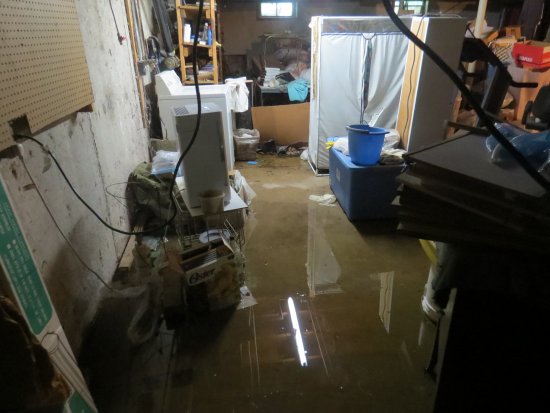
At 2 o’clock on Friday morning I woke up and went downstairs to continue vacuuming the new side of the basement. I looped the extension cord over some boxes and cabling in the ceiling of the basement to eliminate the need to disconnect the extension cord from the machine every time. I concentrated on the new side and filled four barrels with water. It took me about thirty minutes, but there was no discernible effect on the level of the water. I went back to bed and slept like a dead man.
When I awoke again and checked the basement, both sides seemed worse. The water level on the new side was considerably higher, and the entire old side now had at least a filmy coating of water. I could see no dry spots. Where was the water coming from?5 I had to move the cats’ litter box upstairs. I was afraid to move the open box of litter because I could see that the bottom would fill out. I left it where it was and resolved to buy a new box at Shop-Rite.
I worked all day on the basement—not counting a few naps. In all I sucked up about forty-five barrels of water, which produced a notable difference in the level in the new side, about as much as I expected—an inch or so. I kept the hatch closed because I remembered that this was mosquito season, and I had heard warnings about West Nile virus. The mosquitoes that carry the virus like to breed in standing water.
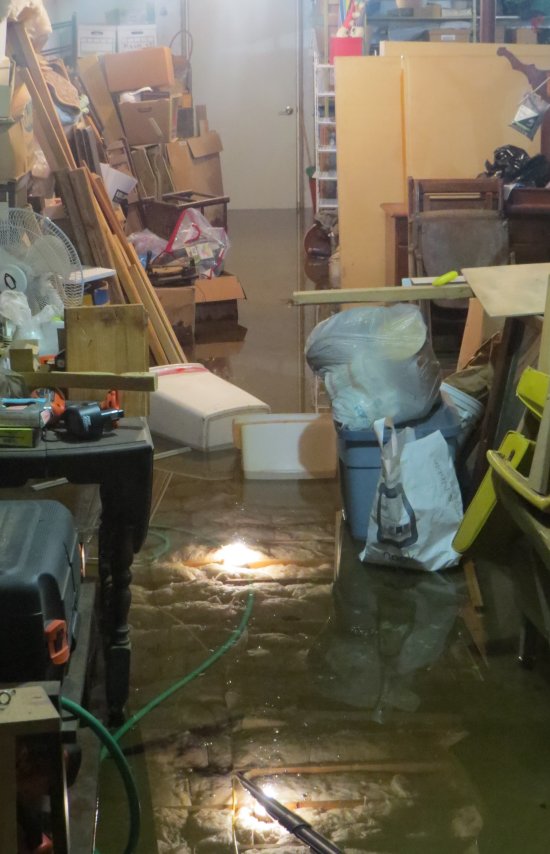
When I awoke on Saturday morning there was quite a bit more water than was there before. I checked the new side. The level was a little higher than when I started on Friday. So, more than an inch of water had seeped back in overnight. This was very discouraging. In fact, I decided to abandon vacuuming until the amount of water stabilized. I checked several times a day when I emptied the dehumidifier
I did figure out that I could move the cardboard box of cat litter upstairs if I tipped it sideways. Once I got it upstairs I split a large hold in the middle of what was now the top side. I could then scoop out dry litter with a ladle. In fact, I was able to salvage the entire contents of the box.
On Tuesday September 7 I decided that the water levels had finally stabilized. The dehumidifier seemed to be doing a good job of drying out the old part of the basement, and the newer side was no worse than on Monday evening. I therefore set to work. By 5 o’clock in the afternoon I had sucked up fifty barrels of water from my position on the ramp. I could definitely see the effect on the water level on the ramp itself.
By this time I had refined my technique pretty well. I positioned the machine on the flat part of the wooden ramp with two wheels on the cement floor of the old basement. When the barrel had filled, I detached the top part of the vacuum and rolled the barrel the fifteen or twenty feet to the washer. I straddled the barrel, bent at the knees, held the handle of the bucket in my left hand, and placed my right fingertips in the indentation on the bucket. I then filled the bucket as much as possible and lifted it up to the washer. This method was the easiest on my back. It also minimized the splashing.
I could do the entire process in four or five minutes. I also saved a little time by only running the spin cycle on the washer every other time. The tub of the washer could hold a little more that two of the vacuum’s barrels. This spin cycle lasted longer than it took the vacuum to fill with water. So, I had a short break every other barrel while I waited for the washer.
On Wednesday I played bridge with Eric Vogel. Afterwards I sucked up another twenty barrels.
On Thursday I was up early enough to run the vacuum through another twenty barrels before playing bridge with Jeanne Striefler at 10 AM. Between rounds Lesley Meyers asked me what had happened to my elbow. I had no idea what she was talking about.
I did another twenty barrels when I arrived home.
Friday was an epic day. I filled and emptied thirty barrels in the morning. The water level near the end was low enough that I had to abandon the ramp for the afternoon session. I added the second extension cord and change the looping of the cords so that I could walk all the way to the hatch and still keep the cords dried.
I vacuumed up seven more barrels in the afternoon, but because the water was now not nearly as deep, it took as long as the morning session.
Most of my time in the afternoon was in two places—right before the hatch and about halfway between the ramp and the hatch. These areas, which were evidently low points, were frustrating because as soon as I would get an area dry, it would fill back up with water seeping in from areas that were filled with some kind of junk that belonged to the other resident of the house. I went back and forth between the two areas.
When I unplugged the vacuum’s cable from the extension cord, I noticed that the vacuum’s male plug was hot. I had already noticed that one of the two prongs was shorter than the other. I could now see that the short one consisted of two pieces of metal that had a slight gap between them. I reported this to Sue. She said that it was a definite fire hazard.
I went back the next two days to work on those two areas. On Saturday I was surprised to find the other cat, Bob, lying on the cement on the path in the new side. There were also a few cat prints near the puddle in the middle. I carried Bob to the staircase, and he easily made his way up. I then extracted about a half barrel.
Much less than that came out on Sunday. When I had finished, the new side was pretty much dry. I could see a few small puddles, but there was no way to get at them with the vacuum.
In the afternoon Sue and I were scheduled to go to a picnic for her cousins on the Locke side. As we were about to leave, she exclaimed, “Ooh! What did you do to your elbow?” I asked her what she meant. She drew my attention to a golf-ball-sized lump on the point of the left one. I had to twist my arm around to see it. I then recalled Lesley’s remark on Thursday. I must have already had it then.
After the picnic Sue and I drove to the to Urgent Care clinics on Hazard Avenue. Neither was open.
On Monday morning, September 13, I drove to the PhysicianOne Urgent Care, the one on the north side of the street. I had been to this location once before, but I am pretty sure that in the interim it had closed and reopened under new management (Yale New Haven Hospital). I arrived at 10 o’clock, with hopes of being home by noon.
I did not know that one made appointments at Urgent Cares. The lady at the desk told me that it would be at least two hours until they could see me. Although most people were required to wait in their cars for a text message, she let me sit in the lobby, where there were only a few usable chairs. The rest of the chairs were Xed off to prevent them from being used. So, I did not get within ten feet of any other patients. That is a good thing because most of them were there to get Covid-19 tests or treatments. The delta variant was still quite active.
One Hispanic lady came in with two children. The boy was about 2’6″ tall. His sister was a little taller. The lady’s mother had a third infant in her arms. They never checked in or entered the treatment area. The lady seemed to be busy with some papers or something. Then the whole family suddenly departed. On the way out I noticed that she was pregnant again.
he physician’s assistant finally saw me after I had been there for nearly three and a half hours. I had spent the time proofreading and rewriting my blog entry concerning 9/11 (which is now posted here). She quickly diagnosed my problem as bursitis. Some other young ladies x-rayed my elbow and wrapped it for me. The P.A. then advised me that if the swelling had not gone down in a week that I should see a physician who specialized in joints. She provided me with the business card of one and a CD that contained my x-rays. .
By Sunday, September 17, the old side was also nearly completely dry. I opened the hatch again to try to air out the new side of the basement. The dehumidifier on the old side shows a reading of 60 percent humidity. It was consistently at 75 or 80 when the water was at its highest.
The knob on my elbow had shrunk a lot. It never did hurt or hinder me in any significant way. I did not plan to call the doctor, but a couple of weeks later the bump was still significant. I tried to schedule an appointment with the doctor recommended by the Urgent Care clinic, but he was out of the office until the end of October, and he only saw patients in Rocky Hill and Farmington, which are both more than thirty minutes away. Fortunately, his receptionist referred me to a doctor who has office hours in Enfield.
On Wednesday, October 6, I had an appointment with Dr. Nicholas Bontempo. He told me essentially what the P.A. had told me earlier. He gave me an elastic “sleeve” to wear over the elbow. It was much more comfortable, but it seemed to provide less compression. So, I applied the wrap over the sleeve.
They scheduled a follow-up appointment for me for November 3. I canceled on October 11. By then the bump was negligible.
Although there had never been standing water in the basement since we had moved to Enfield in 1988, the new (northern half) of the basement was flooded again in April of 2024. My efforts in dealing with that mess have been described here.
1. Hurricane Ida described a very unusual path. It first hit land in Venezuela. It then turned northwest, crossed the Caribbean Sea, a tip of Cuba on August 27, and the Gulf of Mexico before landing again near New Orleans on August 29 as a Category 4 hurricane.
From there it headed northeast, losing strength but dumping a huge quantities of rain everywhere it went. On September 1 it reached the New York City area and caused widespread flooding. It finally petered out in the maritime provinces of Canada.
2. In 2007 Sue and I began the process of refinancing the house and building an addition that was approximately the same size as the original house. A description of this activity was posted here. The addition also had a full basement, which could be reached through an external hatchway in the lawn north of the house. It could also be reached through a door in the northwest corner of the old basement.
3. I had never heard of a Shop-Vac until I ate lunch with Barbara Schane Jackson, TSI’s liaison for the installation at Hecht’s (described here). For some reason she mentioned that she needed to use one. I nodded sagely even though I had no idea what she was talking about. Johnson County in Kansas, where I grew up, is not exactly prone to flooding.
4. If there was ever an indication on the machine of Shop-Vac’s capacity, it had long since been lost. I estimated the size of the barrel at fifteen or sixteen gallons based on the number of fourteen-quart buckets required to empty it.
The new side of the basement was approximately fifty feet by twenty feet—one thousand square feet or 144,000 square inches. One gallon is equivalent to 231 cubic inches. So, each inch of water on the new side contained over 623 gallons. If the barrel contained fifteen gallons, about 41.5 barrels would be required to lower the water level by one inch (assuming no replacement).
5. An admittedly biased description of the process of flooding from the water table is posted here. Perhaps our contractors did not do a perfect job when they installed the new basement.



